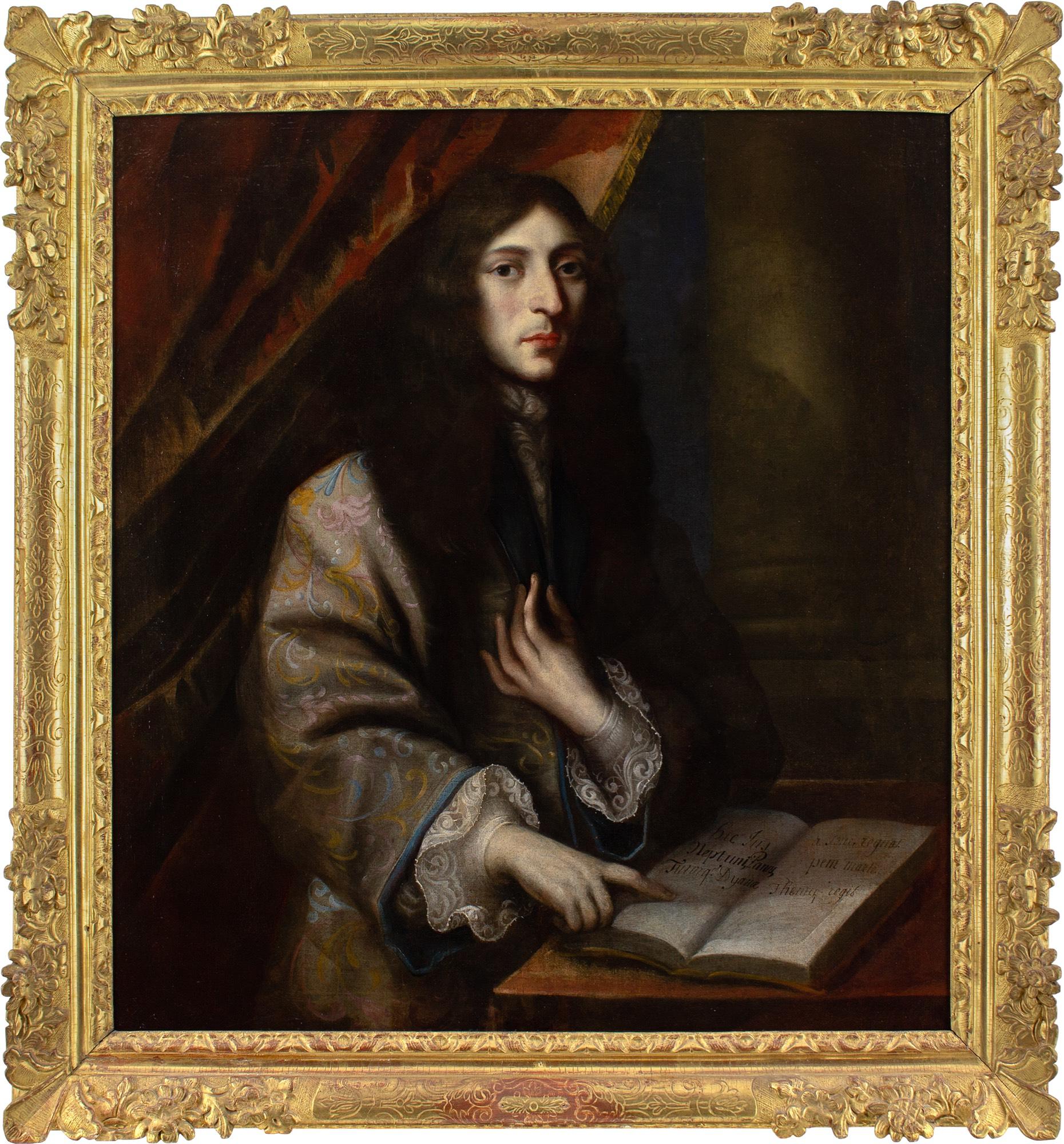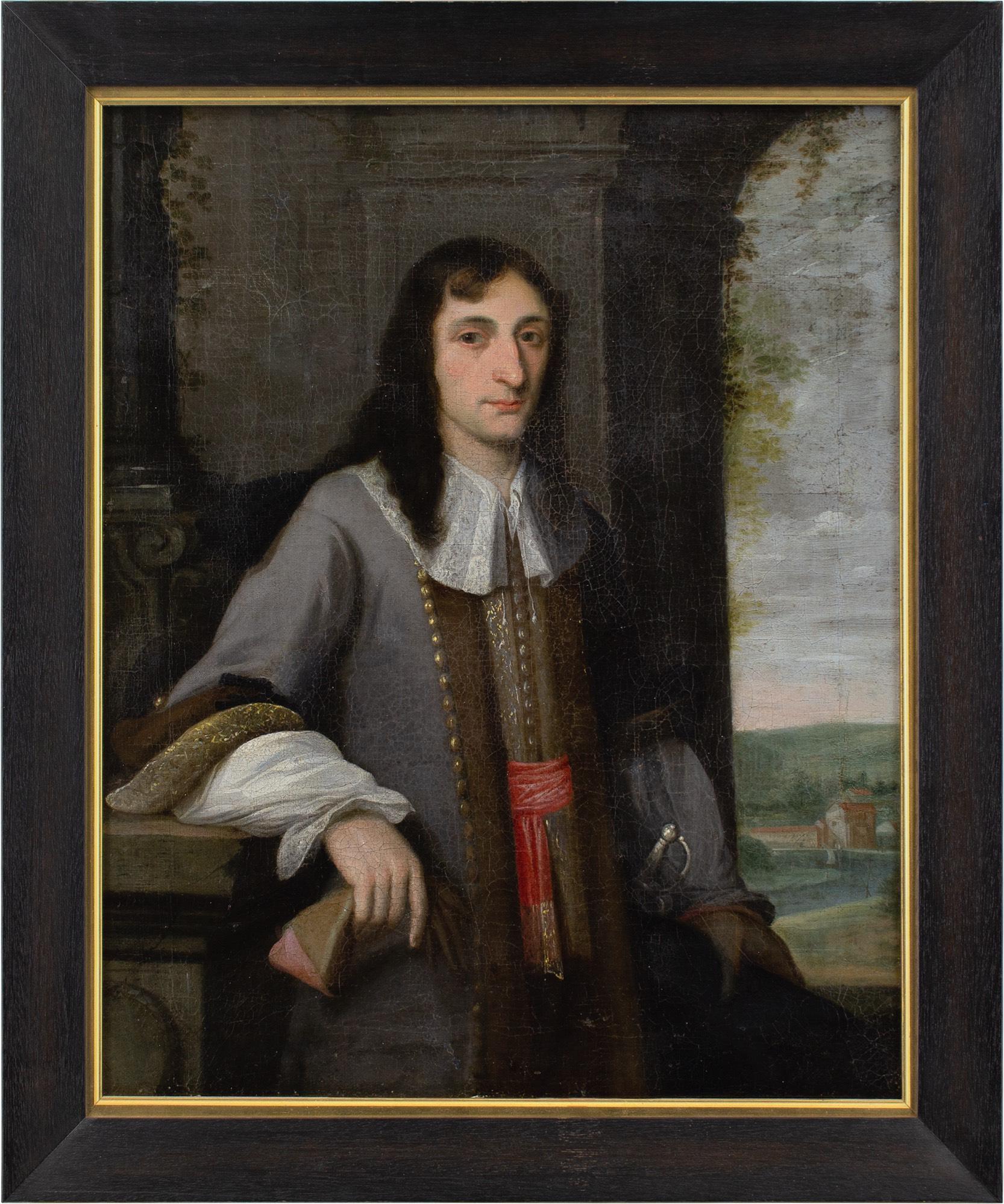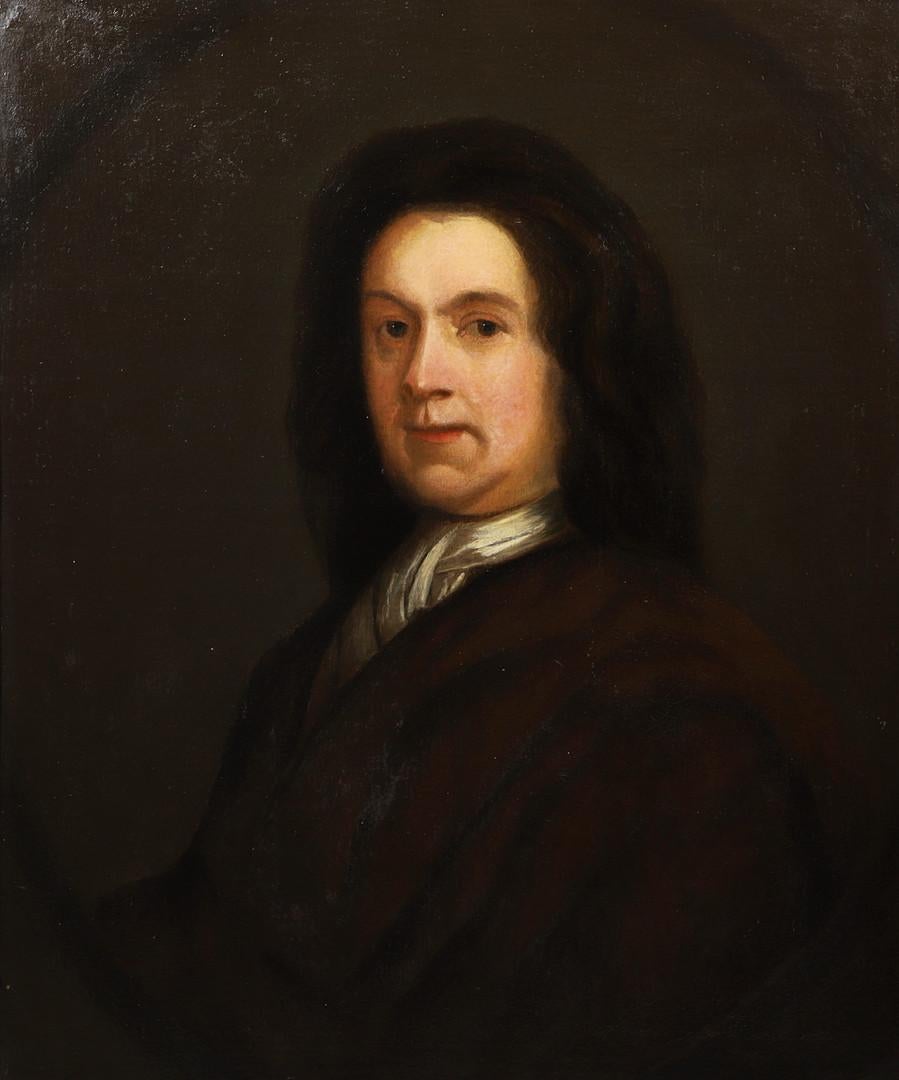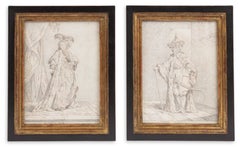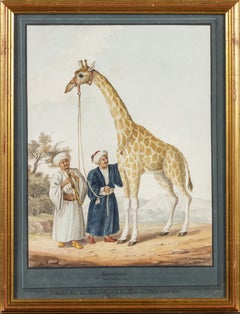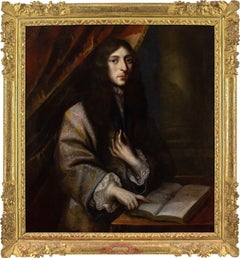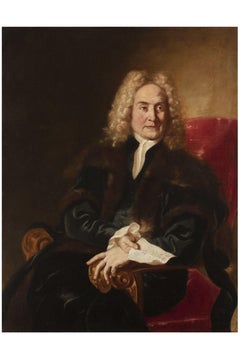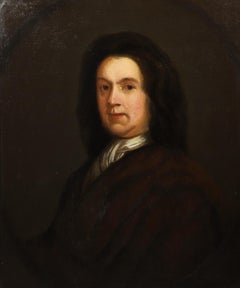Items Similar to Male and female portrait, both in silk kimono, possibly textile dealers
Want more images or videos?
Request additional images or videos from the seller
1 of 7
Christoffel LubienieckiMale and female portrait, both in silk kimono, possibly textile dealersCirca 1680
Circa 1680
$38,516.68
£28,020.46
€32,000
CA$52,564.22
A$58,535
CHF 30,464.23
MX$721,729.46
NOK 387,985.29
SEK 364,668.56
DKK 243,534.90
Shipping
Retrieving quote...The 1stDibs Promise:
Authenticity Guarantee,
Money-Back Guarantee,
24-Hour Cancellation
About the Item
CHRISTOFFEL LUBIENIECKI (1659-1729)
Pair of portraits of a gentleman and a lady, both in silk kimono, before a country house (circa 1680)
Indistinctly signed “C.......” on a box under the man’s left hand
Oil on canvas, 79.5 x 67 cm each
Both sitters are portrayed wearing a silk “Japanese” coat. During the second half of the seventeenth the Japanese silk coat, an adapted Japanese kimono, became a real vogue in the Dutch elite. The exclusive Dutch trade contacts with Japan can explain the popularity of the kimono-style silk coats in the Netherlands. Everybody who could afford one, dressed in such a fashionable and comfortable coat and, like the present sitters, some proud owners had themselves portrayed in a “Japanese” coat often together with an oriental carpet to underline their standing and international connections. These portraits are the work of the Polish-born portraitist Christoffel Lubieniecki (also known as Lubienitski, Lubinitski or Lubiniecki)
Lubieniecki was first trained in Hamburg under Julian Stuhr and after 1675 in Amsterdam under Adriaen Backer and Gerard de Lairesse. He specialized in landscapes, generally of an Italianate character, and in portraits. The loving execution of these contented burghers, enjoying the garden vistas of their country house, places him alongside Amsterdam portraitists such as Constantijn Netscher and Michiel van Musscher, especially in the fastidious detailing of the silk coats and oriental carpets. In the Rijksmuseum Amsterdam, there are several portraits by Lubieniecki, among them portraits of Rear Admiral Arent van Buren and his wife in a more French-oriented baroque style, dated 1721.
Provenance:
Rashleigh-Belcher family, by descent to Dr, Rashleigh-Belcher
Sotheby's, New York City, 1986-11-05, lot 106
Art dealer William Thuillier, London
Christie's Amsterdam, 2006-05-10, lot 108
[.....]
Hampel Kunstauktionen (Munich), 2010-06-16, lot. 553
Literature:
Lewicka-Morawska, A. Slownik malarzy polskich, Warszawa 1998, p. 107
Registered at the Dutch Art Historical Archives in The Hague (RKD)
- Creator:Christoffel Lubieniecki (1659 - 1729, Polish, Dutch)
- Creation Year:Circa 1680
- Dimensions:Height: 31.34 in (79.6 cm)Width: 26.38 in (67 cm)Depth: 1.97 in (5 cm)
- Medium:
- Movement & Style:
- Period:1680-1689
- Framing:Frame IncludedFraming Options Available
- Condition:
- Gallery Location:Amsterdam, NL
- Reference Number:1stDibs: LU147128029352
About the Seller
No Reviews Yet
Vetted Professional Seller
Every seller passes strict standards for authenticity and reliability
1stDibs seller since 2021
- ShippingRetrieving quote...Shipping from: Amsterdam, Netherlands
- Return Policy
Authenticity Guarantee
In the unlikely event there’s an issue with an item’s authenticity, contact us within 1 year for a full refund. DetailsMoney-Back Guarantee
If your item is not as described, is damaged in transit, or does not arrive, contact us within 7 days for a full refund. Details24-Hour Cancellation
You have a 24-hour grace period in which to reconsider your purchase, with no questions asked.Vetted Professional Sellers
Our world-class sellers must adhere to strict standards for service and quality, maintaining the integrity of our listings.Price-Match Guarantee
If you find that a seller listed the same item for a lower price elsewhere, we’ll match it.Trusted Global Delivery
Our best-in-class carrier network provides specialized shipping options worldwide, including custom delivery.More From This Seller
View AllSelf-portrait in Indonesian Landscape
Located in Amsterdam, NL
Abraham Johannes Romswinckel (1810-1856)
Self-portrait in Indonesian landscape
Inscribed Abr. Joh. Romswinckel, geb. Batavia 17 Oct. 1810, overl...
Category
1820s Romantic Portrait Paintings
Materials
Canvas, Oil
Costume drawings for ‘Ambassadeur de Siam’ and ‘La Sultana Reine’
Located in Amsterdam, NL
Joseph-Marie Vien (1716-1809)
‘Ambassadeur de Siam’ and ‘La Sultana Reine’
Both titled lower centre, the drawing of the ambassador inscribed with colours intended for the prints, e...
Category
Mid-18th Century Old Masters Figurative Drawings and Watercolors
Materials
Paper, Pencil
The King's Camelopard
Located in Amsterdam, NL
Charles Frederick de Brocktorff (1775–1850)
‘Camelopard – a present from the Pacha of Egypt to the King – at Malta on its way to England’
Signed and dated C.F. de Brocktorff. / 1827. lower right, inscribed as titled in the painted margins lower centre. Pencil and watercolour heightened with gold paint and gum arabic on paper, 36.8 x 27.9 cm
A gift so majestic, it made kings blush, and a gift so grand, it would startle Europe into a craze. Pasha Muhammad Ali of Egypt (1805-1848) did it in 1827: he sent to Europe three magical spotted, horned creatures, each with a neck reaching the skies and legs as long as a house is high. One giraffe to King Charles X of France, one to Francis I of Austria and the most fabled one to King George IV of England. A curious sight for Europeans, who had not seen such a beast since the Medici giraffe in 1487.
Few animals created more of a stir in Europe than these royal...
Category
1820s Naturalistic Animal Drawings and Watercolors
Materials
Gold
Portrait of a Chinese Man
Located in Amsterdam, NL
Lazlo Tatz (Hungary 1888 - Philippines 1951)
Portrait of a Chinese man
Oil on canvas, H. 50 x W. 44.5 cm
Tatz studied in Budapest and Paris, and in 1931 h...
Category
Early 20th Century Portrait Paintings
Materials
Canvas, Oil
Portrait of a Geisha
By Roland Strasser
Located in Amsterdam, NL
Roland Strasser (1895-1974)
"Japanese Geisha"
Signed lower right
Oil and gold leaf on canvas, measures: 76 x 46 cm
In fine white-wash wood frame.
...
Category
1930s Expressionist Portrait Paintings
Materials
Gold Leaf
A Chinese Company playing Droughts
Located in Amsterdam, NL
ERWIN BINDEWALD (1897-1950)
Two men playing draughts, a girl with the red book standing behind them
Signed and dated E. Bindewald d.j., 27
Oil on canvas, 140.5 x 90.5 cm
In black and gilt gesso frame.
Note:
Bindewald was born in Charlottenburg. He moved to Berlin in 1914 where he studied till 1924 at the Berliner Kunst Akademie. Bindewald travelled in Europe, but mainly stayed in Germany and certainly never was in China. This painting was made in Europe, presumably in the China Town of Berlin. Bindewald received several commisions in Germany from factory owners who wanted their factories painted inside, usually with workers, as well as outside. In the present painting the sitter on the right seems to be a man with a Manchurian background, wearing the brown coat reserved for the highest aristocracy in China.
In China the black sleeve-ends completely cover the hands, indicating that the high aristocracy does not have to do any manuel labour. This man clearly is not a factory worker but he possibly is the (co)- owner of the factory in the background and as such might need his hands to do at least some writing. The man on the left in the modern Western suit...
Category
1920s Art Deco Portrait Paintings
Materials
Canvas, Oil
You May Also Like
Jacques d'Agar (Circle), Portrait Of A Gentleman In A Silk Robe
Located in Cheltenham, GB
This enchanting late 17th-century French oil painting depicts an elegant gentleman in a silk robe with his right index finger on an open book. Stylistically, it’s comparable to the oeuvre of Jacques d'Agar (1640-1715).
Dressed in a rather ostentatious embroidered silk robe...
Category
1670s French School Portrait Paintings
Materials
Oil, Canvas
17th-Century Flemish School, Portrait Of A Gentleman In A Justaucorps
Located in Cheltenham, GB
This fine late 17th-century Flemish portrait depicts a distinguished gentleman wearing a justaucorps, black cloak, white shirt, vest, leather gloves, and breeches. He’s carrying a wi...
Category
1670s Old Masters Portrait Paintings
Materials
Oil, Canvas
17th-18th Century By Niccolò Cassana Portrait of a Gentleman Oil on Canvas
Located in Milano, Lombardia
Niccolò Cassana (Venice, Italy, 1659 - London, UK, 1714)
Title: Portrait of a Gentleman
Medium: Oil on canvas
Dimensions: without frame 119.5 x 92.5 cm
Painting without frame.
Expe...
Category
17th Century Old Masters Portrait Paintings
Materials
Canvas, Oil
Fine Large 17th/ 18th Century English Portrait of Mr. Gilbert Charity Founder
Located in Cirencester, Gloucestershire
Portrait of Mr. Gilbert (believed to be the founder of 'Gilberts Charity, Bridgwater, Somerset)
English School artist, late 17th/ early 18th century
oil...
Category
Late 17th Century Old Masters Portrait Paintings
Materials
Oil, Canvas
Portrait of Monsieur Aubert, a ceremonial portrait by Nicolas de Largillière
By Nicolas de Largillière
Located in PARIS, FR
Provenance :
Arnold S. Kirkeby (1901-1962)
Donated by Arnold S. Kirkeby to the Los Angeles County Museum of Art in 1955, where it remained until its sale at Sotheby's, New York on Ja...
Category
1720s Old Masters Portrait Paintings
Materials
Oil
Portrait of a Gentleman in Scarlet Robe Holding Flowers c.1675, Oil on canvas
Located in London, GB
Titan Fine Art present this striking portrait, which was painted by one of the most talented artists working in England during the last half of the 17th century, John Greenhill. Gre...
Category
17th Century Old Masters Portrait Paintings
Materials
Canvas, Oil
More Ways To Browse
Antique Dealers
Polish Textiles
Antique Silk Paintings
Antique Portrait Box
Framed Japanese Textiles
Japanese Silk Dress
Hand Painted Kimono
Kimono Box
Antique Silk Kimono
Antique Silk Kimonos
Antique Japanese Kimono Kimonos And Textiles
Hideki Fujii
Hip Hop Honeys
Hirst Honour
Hockney Woldgate
Hoffman Beverages
Hogarth Election
Hope Olson
